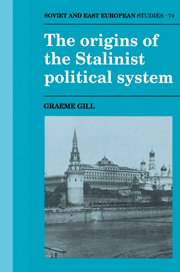Book contents
- Frontmatter
- Contents
- Preface
- Abbreviations
- Introduction: What is Stalinism?
- PART I COHESIVE OLIGARCHY 1917–1922
- PART II THE FRACTURED OLIGARCHY 1922–1929
- Part III THE RE-FORMED OLIGARCHY, 1930–1934
- PART IV THE OLIGARCHY SUBDUED, 1935–1941
- 7 The enduring structures of sub-national politics
- 8 Elite ravaged
- Conclusion: Why Stalinism?
- Notes
- Bibliography
- Index
- Soviet and East European Studies
7 - The enduring structures of sub-national politics
Published online by Cambridge University Press: 11 September 2009
- Frontmatter
- Contents
- Preface
- Abbreviations
- Introduction: What is Stalinism?
- PART I COHESIVE OLIGARCHY 1917–1922
- PART II THE FRACTURED OLIGARCHY 1922–1929
- Part III THE RE-FORMED OLIGARCHY, 1930–1934
- PART IV THE OLIGARCHY SUBDUED, 1935–1941
- 7 The enduring structures of sub-national politics
- 8 Elite ravaged
- Conclusion: Why Stalinism?
- Notes
- Bibliography
- Index
- Soviet and East European Studies
Summary
The sense of insecurity which had pervaded party ranks in the early part of the 1930s did not disappear in the latter half of the decade. The isolation remained, fuelled in part by continuing peasant resentment over collectivisation and a degree of popular alienation engendered by the Terror. The rhetoric associated with the search for enemies and the 1936–38 Terror would have fed into and reinforced this feeling. But the extent of popular hostility should not be exaggerated. Many would have accepted the official explanation for the Terror, if only because this offered at least an understandable framework for what was otherwise an incomprehensible phenomenon. The new state constitution of 1936 was also important, offering a symbolic place in the polity for the populace. But of greater importance was probably the continuing expansion of opportunities for social mobility.
The processes of industrialisation and agricultural collectivisation had opened up massive opportunities for social mobility to those from the lower levels of society. The continuing expansion of industrialisation, and the growth of urban areas in the Second (1933–37) and Third (1938–42) Five Year Plans ensured that the channels of mobility remained open. This was stimulated by the effect of the purges; every position left vacant by someone who was purged had to be filled by a newcomer, a development which usually involved a promotion. The scale of this was significant; according to the new First Secretary of the Western Oblast in October 1937, within the preceding three months some 1,000 people had been promoted to leading posts.
- Type
- Chapter
- Information
- The Origins of the Stalinist Political System , pp. 259 - 274Publisher: Cambridge University PressPrint publication year: 1990



